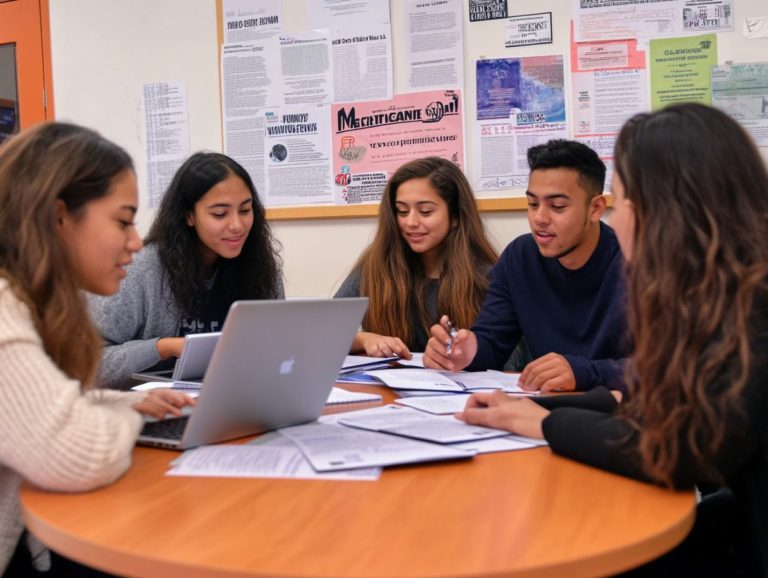How to Stay Organized During Scholarship Applications
Navigating the scholarship application process may seem daunting, but staying organized is crucial for your success!
This article offers practical tips to streamline your efforts. From designing effective checklists to tracking deadlines diligently and organizing your materials, we have you covered!
Discover strategies that can enhance your chances of securing funding. This includes targeted research, crafting a compelling personal statement, and obtaining strong letters of recommendation.
With the right approach, you can present a polished application that truly stands out. So, let s dive in and get started!
Contents
- Key Takeaways:
- Understanding the Process
- Tips for Staying Organized
- Maximizing Your Chances of Success
- Frequently Asked Questions
- How can I stay organized during scholarship applications?
- What tools can I use to stay organized during scholarship applications?
- How can I prioritize my scholarship applications?
- What are some tips for staying organized while writing scholarship essays?
- How can I stay on top of my recommendation letters during the scholarship application process?
- What should I do with my completed scholarship applications?
Key Takeaways:

- Stay organized by creating a checklist to keep track of requirements and deadlines.
- Maximize your chances of success by researching and targeting scholarships, crafting a strong personal statement, and obtaining recommendations.
- Submit a complete and polished application by organizing all necessary materials and paying attention to details and instructions.
Understanding the Process
Understanding the scholarship application process is essential for students seeking financial assistance for their education. This multifaceted journey requires you to explore various resources to gather crucial information about scholarships, application materials, and deadlines.
By breaking down this process, you can create a comprehensive strategy that showcases your achievements. This strategy will help you navigate the complexities of applications and requirements with ease and efficiency.
Tips for Staying Organized
Staying organized during the scholarship application process can significantly boost your chances of success. Effective planning tools like Google Sheets or Excel help you track deadlines and manage your application materials with ease.
Establish a streamlined organization system that incorporates notes, reminders, and task lists. This ensures that every critical document and deadline is accounted for, leaving no room for oversight.
Creating a Checklist
Creating a comprehensive checklist is a vital step in your scholarship journey. This checklist allows you to manage your submissions precisely.
A well-structured checklist should include:
- Essays
- Recommendations
- Transcripts
Make sure to note their corresponding due dates to meet every deadline!
It’s wise to categorize your tasks by priority and deadlines, focusing first on those that are both time-sensitive and highly competitive. Including specific requirements in your checklist can be very helpful; for example, some scholarships may ask for a portfolio or extra essays tailored to particular prompts.
Regularly review your progress against this checklist. This will help you identify any gaps in your materials or tasks, leading to a more organized and efficient application process. Not only will this method help you avoid missing important details, but it will also give you a thrilling sense of achievement as you check off each completed task!
Keeping Track of Deadlines

Keeping track of deadlines is crucial if you’re aiming to submit your scholarship applications on time. Using a calendar or digital tools to set reminders for each due date can help you sidestep last-minute stress, ensuring that all necessary documents are submitted promptly and accurately.
Leverage both traditional calendars and advanced digital platforms to select the method that best aligns with your organizational style. While physical planners offer a satisfying tactile experience, apps like Google Calendar or Trello provide flexibility and seamless integration with other tools.
Setting reminders not only alerts you about upcoming deadlines but also encourages you to break larger tasks into manageable steps. This can significantly reduce anxiety. Adhering to these timelines is crucial, as missing a due date could mean losing valuable funding opportunities that could greatly elevate your educational journey.
Start creating your checklist today to keep your applications on track and maximize your chances of success!
Organizing Application Materials
Organizing your application materials effectively can truly transform the scholarship application process. By creating dedicated folders, whether you prefer physical binders or digital spaces, you can ensure that all essential documents are easily accessible and systematically arranged. For additional insights, consider the do’s and don’ts of scholarship applications. This not only streamlines your submission process but also adds a touch of professionalism.
Establishing a clear categorization system is crucial. Sort your documents by type or according to specific scholarship requirements to eliminate confusion and make retrieval a breeze. Consider utilizing tools like color-coded labels or tabs to enhance visibility, allowing you to pinpoint necessary materials at a glance.
Setting deadlines for each component and maintaining a checklist a simple list to ensure you have everything you need is essential to avoid overlooking crucial documents. An organized approach alleviates stress and boosts your chances of submitting a polished and complete application, paving the way to success in securing that coveted funding.
Maximizing Your Chances of Success
Boost your chances of winning scholarships with these simple steps! Start by identifying suitable scholarships that align with your goals.
Next, focus on crafting compelling personal statements that truly reflect your unique qualities and aspirations. Strong letters of recommendation can make a significant difference in your application. Ensure that every aspect of your submission is complete and polished.
By implementing these effective strategies, you can significantly enhance your prospects of receiving the financial aid you deserve.
Researching and Targeting Scholarships
Researching and targeting the right scholarships is essential for you as a student seeking to optimize your application efforts. Leverage various resources, including scholarship databases like Fastweb, to filter and identify scholarships that match your qualifications and experiences.
In addition to using online databases, tap into networking opportunities such as college fairs and community events to connect directly with scholarship providers. Engaging with mentors or alumni can yield valuable insider tips about lesser-known scholarships and offer guidance through the application process.
Refine your search criteria, focusing on scholarships that cater to your unique profile consider academic achievements, extracurricular involvement, and career aspirations. By honing in on the right scholarships, you save time and boost your likelihood of securing financial assistance tailored to your specific needs.
Crafting a Strong Personal Statement

Crafting a strong personal statement is essential in the scholarship application process. It provides you with the platform to showcase your unique experiences and aspirations. A compelling essay conveys your passion, achievements, and future goals, setting you apart from the competition.
To maximize this opportunity, structure your essay coherently. Begin with a captivating introduction that hooks the reader, followed by well-organized paragraphs detailing your personal experiences and insights.
Incorporate specific anecdotes, challenges you’ve faced, and the lessons you’ve learned; these elements enrich your narrative and make it more engaging. By articulating your personal growth and future aspirations, forge a meaningful connection with the reviewers.
Ultimately, this essay reflects your personal journey and plays a crucial role in influencing your application s overall success, significantly enhancing your chances of securing that coveted scholarship.
Obtaining Strong Letters of Recommendation
Obtaining strong letters of recommendation is crucial for students pursuing scholarships. These letters provide insights into your character and qualifications. It’s essential for recommenders to understand the specific qualities scholarship committees seek.
Select individuals who genuinely know you teachers, mentors, or supervisors. They can effectively articulate your strengths and accomplishments. When approaching recommenders, provide a personal statement or resume that showcases your academic successes and career goals. This information helps them frame their letters to align with scholarship criteria.
Initiating this conversation well in advance gives your recommenders ample time to craft detailed letters that truly reflect your abilities.
Submitting a Complete and Polished Application
Submitting a complete and polished application is the final step in the scholarship process that can determine your success. Ensure all required materials are included and each document is carefully checked for mistakes.
Dedicate time to review your application before submission. Check for common errors, confirm all required documents are present, and ensure your information is clear and professional.
Organizing these materials can be a game changer. Create a checklist or an online folder to keep everything in order and easily accessible. A well-organized application showcases your attention to detail and reflects your commitment to presenting your best self. This can greatly sway the selectors’ decision!
Frequently Asked Questions
How can I stay organized during scholarship applications?

- Make a list of all the scholarships you plan to apply for, including deadlines and requirements. This helps you track what needs to be done.
- Use a planner or calendar to mark important dates and set reminders. This keeps you on top of deadlines.
- Create a separate folder or binder for each scholarship application. This makes it easier to find important documents.
What tools can I use to stay organized during scholarship applications?
- Various online tools and apps, like Evernote and Trello, can help you stay organized. These allow for checklists, reminders, and document storage.
- You can also use physical tools, such as color-coded folders and sticky notes, for tracking your applications.
- Find a system that works best for you and stick to it to stay organized throughout the process.
How can I prioritize my scholarship applications?
- Start by identifying scholarships with the earliest deadlines and prioritize those first.
- Consider eligibility requirements and your chances of receiving the scholarship when prioritizing applications.
- It’s wise to prioritize scholarships that require similar materials, allowing you to work on them simultaneously.
What are some tips for staying organized while writing scholarship essays?
- Read the essay prompts carefully and note the key points to address. This keeps you focused while writing.
- Create an outline before writing your essay. This provides structure and makes the process more efficient.
- Track the word count and any formatting requirements for each essay to ensure you adhere to guidelines.
Start organizing your applications today!
How can I stay on top of my recommendation letters during the scholarship application process?
1. Request letters of recommendation early. Provide people writing your letters with all the necessary information, such as deadlines and requirements.
2. Set reminders for yourself. Follow up with those writing your letters if they haven’t submitted by the deadline.
3. Thank your recommenders! Keep them updated on the status of your scholarship applications.
What should I do with my completed scholarship applications?
1. Make copies of all your completed applications. Keep supporting documents for your records.
2. Track when and where you submitted each application. This helps in case you need to follow up or provide additional information.
3. Once you’ve submitted an application, focus on the next one. Resist the urge to constantly check the status of your previous applications.






